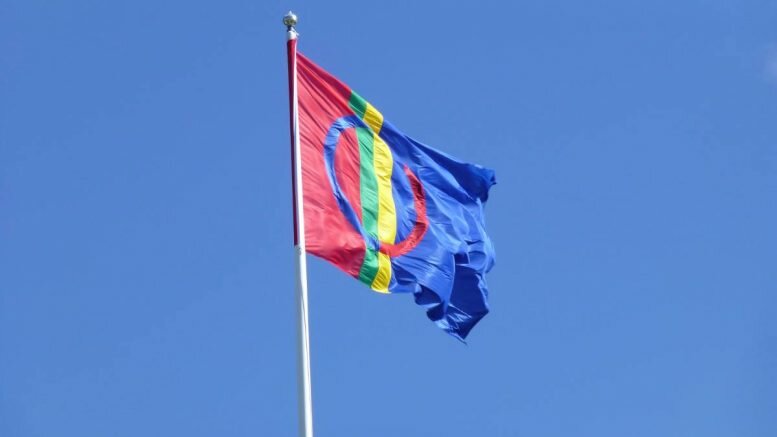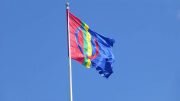The Sámi people, indigenous inhabitants of areas in Norway, Sweden, Finland, and Russia, have been living on the northern edges of the world for thousands of years. Along with ‘ethnic Norwegians’, the Sami are recognized as indigenous people of Norway. However, the relationship with ‘ethnic Norwegians’ has a history steeped in discrimination and exploitation. It is only in the past three decades of the modern age that the Sámi, with a vivid history and rich cultural traditions, have had strides in the story of Norway.
Who are the Sámi?
The Sámi are an indigenous people who speak a Finno-Urgaic language and who inhabit an area of Northern Europe that they call Sápmi. Often referred to, in English, as the ‘Cap of the North,’ this includes the northern parts of Norway, Sweden, Finland, and Russia in a roughly triangular area between the Norwegian Sea, Barents Sea, and the White Sea.
With an estimated 2 million Sámi living worldwide, most are concentrated in Northern Norwegian municipalities, especially Troms and Finnmark. There are approximately 850,000 Sami living in Norway today.
Distinctive language and culture
The language of the Sámi people is from the Uralic language family and it’s most closely associated with the Finnic languages (think modern-day Finnish or Estonian). It is the official minority language of the different national jurisdictions in the Sampi and has nine different dialects.
The Sámi have a distinct and rich cultural heritage, with traditional industries including reindeer herding, fishing, and folk arts and crafts. However, many Sámi nowadays have moved away from traditional forms of employment and to the tourism industry. Many live in cities now, with some 80,000 Sami living in Oslo… A significant amount of the city’s population.
Sami history up until the 18th century
The Sami have been living in Northern Norway since, at the very least, 1500 BCE. In most areas of the Sapmi, they are the original inhabitants and have been living in that area for hundreds of generations longer than the ‘ethnic Norwegians.’
Up until the early modern period, the Sámi people were left relatively isolated and alone. Having adapted, over generations, centuries, and millennia, to life in the Arctic Circle, they were less reliant on supplies from southern Norway. As ‘ethnic Norwegians’ began to settle the north and build villages and towns, pressure increased on the Sami’s traditional pasture grounds for reindeer.
This pressure was further heightened with the emergence of Sweden as a regional power during the 17th and early 18th centuries. This culminated in a century-long battle, between Sweden and Russia, for control of Northern Europe that climaxed in ‘The Great Northern War.’ It was decisively won by Russia in 1721.
This area, on the northern fringes of Europe, became of valuable strategic importance to the Russian Empire, Denmark-Norway, and the Swedish Empire. As such, migration and construction north further encroached on the traditional Sámi way of life.
Growing economic development and importance of Sápmi
Danish, Norwegian, Swedish, and Russian missionaries were amongst the first ‘outsiders’ to arrive in Sápmi. At first, the missionaries made great efforts to understand the language and culture of the Sámi in order to proselytize them. However, by the 18th and 19th centuries, more and more was done to force the Sámi into a different way of life. The shamanic rituals that were a part of their everyday life were first downplayed then outrightly banned by Christian missionaries.
Throughout the 19th century, the north of Norway becoming increasingly economically important to the national powers of the time. As Norway passed from Danish control to Swedish, after the Napoleonic Wars, a bigger and bigger economic focus was put into the area. Cities began to develop and heavy industries, like fishing, became mainstays of northern Norway. With the arrival of such changes, the traditional Sámi way of life was further marginalized. Unfortunately, worse was yet to come.
Forced ‘Norwegianization’
One of the darker periods of Norwegian history was the forced ‘Norwegianization’ of the Sámi people which accelerated especially in the 19th and early 20th centuries. Starting in the 18th century, Norwegian missionaries felt it their duty to not only spread word of their God but also to help ‘civilize’ (from the ethnocentric view of Industrial Revolution-era Europe) the Sámi.
The 19th century saw the rapid effects of the Industrial Revolution. Norway became transformed from a medieval agrarian society into a newly prosperous industrialized country. The Storting, established in the first wave of a Norwegian nationalist movement following the Napoleonic Wars, enacted a law, in 1851, to put money aside to ‘assimilate’ the Sámi. This money was allocated to the employment of Norwegian language teachers and to reward members of the Sámi community with ‘good’ Norwegian language skills.
Social Darwinism and schools
This process only worsened during the latter stages of the 19th and into the early 20th century. Social Darwinism and other pseudo-ethnic ideologies, often used to exploit indigenous peoples the world over, came into vogue.
Sámi place names, which had been used since time immemorial, became ‘Norwegianized’ in order to further assimilate the Sámi into ‘mainstream’ Norwegian culture. The Sámi were seen, by some, as ethnically, socially, physically, mentally, and racially ‘inferior’ to the ‘ethnic Norwegian race’.
For the Sámi, the use of their native language was forbidden and many children were forcibly removed, painfully separated from families and communities, and sent to Christian boarding schools. An 1899 act of the Storting (Wexelsenplakaten) specifically forbade any multilingual education in Norwegian schools. Norwegian (though itself a language of two but similar forms) was decreed to be the only language for education, which was almost entirely run by the State. In fact, up until the 1920s, the Sámi were thought of as ‘abnormal’ and grouped together with the ‘mentally deranged’ in the national census.
The Sámi resurgence
This policy of forced assimilation continued well into the mid-20th century. However, it was during the 1980s that the Sami saw a resurgence and renaissance which has continued until today.
Racial and ethnic policies against minority populations were quickly stopped after the horrid effects of the Second World War. With the Norwegian Government establishing a welfare state, a focus was put on education rather than forced assimilation. The Sámi were to be an accepted part of a post-war Norway whose focus was now on promoting diversity and tolerance.
The Sámi also played an important part in the dawning of a national environmental movement. A series of protests in the late 1970s and early 1980s, against building a hydroelectric plant on the Alta River in Finnmark, helped to establish the fact that Sámi had distinct rights over areas of Northern Norway into the national spotlight. This in turn led to the establishment of the Sami Parliament (Sámediggi), a unicameral parliament of 39 representatives with a high degree of cultural autonomy.
A royal apology and National Sámi Day
The recent years have been a significant shift towards the celebration of the Sámi as a rich part of Norwegian and world culture and history. In 1997, King Harald V, on behalf of the Norwegian Government and State, made an official apology to the Sámi and Kven people for the forced ‘Norwegization’ policy enacted until the mid-20th century.
Since 1993, Norway has celebrated the Sámi National Day, on February 6. This was the date of the first Sámi conference held in Trondheim in 1917. You will see the Sámi flag proudly flown on government buildings, showing how important and integral the Sámi people are to the modern Norwegian state.
Source: #NorwayTodayTravel
Do you have a news tip for Norway Today? We want to hear it. Get in touch at [email protected]





Leave a comment